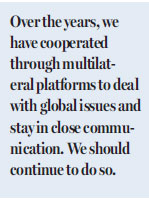Building better China-US relations together for each other

US President Donald Trump is going to start his first presidential visit to China soon. It will be a historic visit for China-U.S. relations, and it comes at an important time.
For China, the 19th National Congress of the Chinese Communist Party that just concluded has set the direction for China's future development for at least the next five years. For the United States, it's the first time President Trump will set foot in China.
Looking back over the past four decades, China-U.S. relations have developed steadily through numerous challenges and dramatic transformations of the world. The breadth and depth of this relationship is beyond anyone's imagination more than 40 years ago.

Today, roughly $1.7 billion of goods and services flows between our two countries every day. China is America's largest export market outside of North America and also the second-largest market for U.S. agricultural exports, accounting for 15 percent of those exports. On average, each U.S. farmer exports about $12,000 of agricultural products to China, which was the United States' largest goods-trading partner last year. And in the e-commerce age, we see huge potential for bilateral trade to flourish further.

According to a report in April by the National Committee on U.S.-China Relations and the Rhodium Group, mutual investment in 2016 amounted to nearly $60 billion. The number of Americans employed by Chinese-affiliated companies rose to more than 140,000 - a 46 percent increase since 2015.
It reminds me of what former Ambassador Gary Locke wrote recently: "A prosperous China is good for the United States. A prosperous China with a growing middle class means greater demand for American-made goods and services. That means more jobs for Americans. Conversely, a strong U.S. economy is good for China."
However, there are some issues that could threaten this mutually beneficial relationship, and the Section 301 investigation initiated by the U.S. trade representative is certainly one of them.
The bilateral trade imbalance is a longstanding issue caused by multiple factors, and there is no quick fix. The current trade-statistics regime, which defines country of origin as the one assembling and exporting the final products, has greatly exaggerated China's surplus. Products assembled in China with none of their components originating from China are counted as Chinese exports.
U.S. restrictions on high-tech exports to China are another major contributor to the deficit. According to an April report from the Carnegie Endowment for International Peace, if the U.S. reduces restrictions on exports to China to the level of those for Brazil, its trade deficit with China would drop 24 percent; and if reduced to the level for France, a 34 percent drop could be expected.
China and the United States are both permanent members of the United Nations Security Council. We both have a responsibility to the global community. Over the years, we have cooperated through multilateral platforms to deal with global issues and stay in close communication. We should continue to do so.
On the Korean nuclear issue, we share the common goal of denuclearization, though we two countries have differences over how to achieve that goal. China remains committed to the denuclearization, peace and stability of the peninsula, and maintains that the issue should be solved through dialogue. China has put forward two approaches. The dual-track approach works to denuclearize the peninsula and establish a peace mechanism in parallel. The "suspension-for-suspension" proposal calls for the Democratic People's Republic of Korea - known to Americans as North Korea - to suspend its missile and nuclear activities in exchange for a halt to joint large-scale military exercises between the United States and the Republic of Korea - known as South Korea - as the first step to initiate the dual-track approach.
China is also open to creative and practical ideas from others, especially the U.S.
We hope President Trump's visit will add momentum to efforts from both sides in fostering a relationship rooted in mutual respect and cooperation, because both our peoples are great peoples, and both the Chinese Dream and the American Dream will have a much better chance to come true when we work together.
The author is Chinese consul general in San Francisco. This article was published on Seattletimes.com on Nov 6 and then on the print edition of Seattle Times on Nov 7.
(China Daily USA 11/09/2017 page12)
Today's Top News
- China defends response to Japanese reconnaissance in East China Sea ADIZ
- Wang calls Rubio meeting constructive
- Tianzhou 9 cargo craft transported to launch site
- Gaokao not only way to be successful in life
- More policy options in H2 to spur growth
- Shipping industry advances green efforts






























